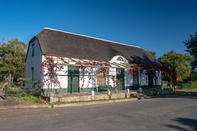Swellendam is a major historical pit-stop on the Great Wagon Road to the east. It was the first real settlement to be established in the Overberg and in 1743, it became the third magisterial district in the Cape (after Cape Town and Stellenbosch). The town was jointly named after the Dutch Governor, Hendrik Swellengrebel and his wife, Helena Ten Damme.

Sending a landdrost out into the wilds of the Overberg may have been a feeble attempt to keep the ever-irascible Trekboers in check, but Swellendam nevertheless became an important administrative centre and the gateway to the interior, but things got off to a slow start. 30 years after it was established, there were still only 4 permanent houses, and life in Swellendam was rather quiet.
Proceedings were somewhat livened up in 1795 when a group of disgruntled farmers threw off the shackles of the Dutch East India Company (VOC) misrule and declared themselves a Republic.
This short-lived ‘democracy’ lasted all of six months, then the British arrived for their first tour of occupation. Deprived of their Dutch nemesis, the fractious members of the Republic couldn’t hold things together and the town soon fell back into its comfortable country stupor.
 In 1743, Governor-general Baron Gustav Wilhelm van Imhoff decreed that a new sub-drostdy should be established far east of Stellenbosch, to ...
In 1743, Governor-general Baron Gustav Wilhelm van Imhoff decreed that a new sub-drostdy should be established far east of Stellenbosch, to ... The lucrative South African wool industry had its start in the Overberg, and Swellendam was its centre - but the town still only had one sto...
The lucrative South African wool industry had its start in the Overberg, and Swellendam was its centre - but the town still only had one sto... Under pressure from the wealthy trading empire, and encouraged by the local farmers, Barry and Nephews parliament finally consented to build...
Under pressure from the wealthy trading empire, and encouraged by the local farmers, Barry and Nephews parliament finally consented to build...